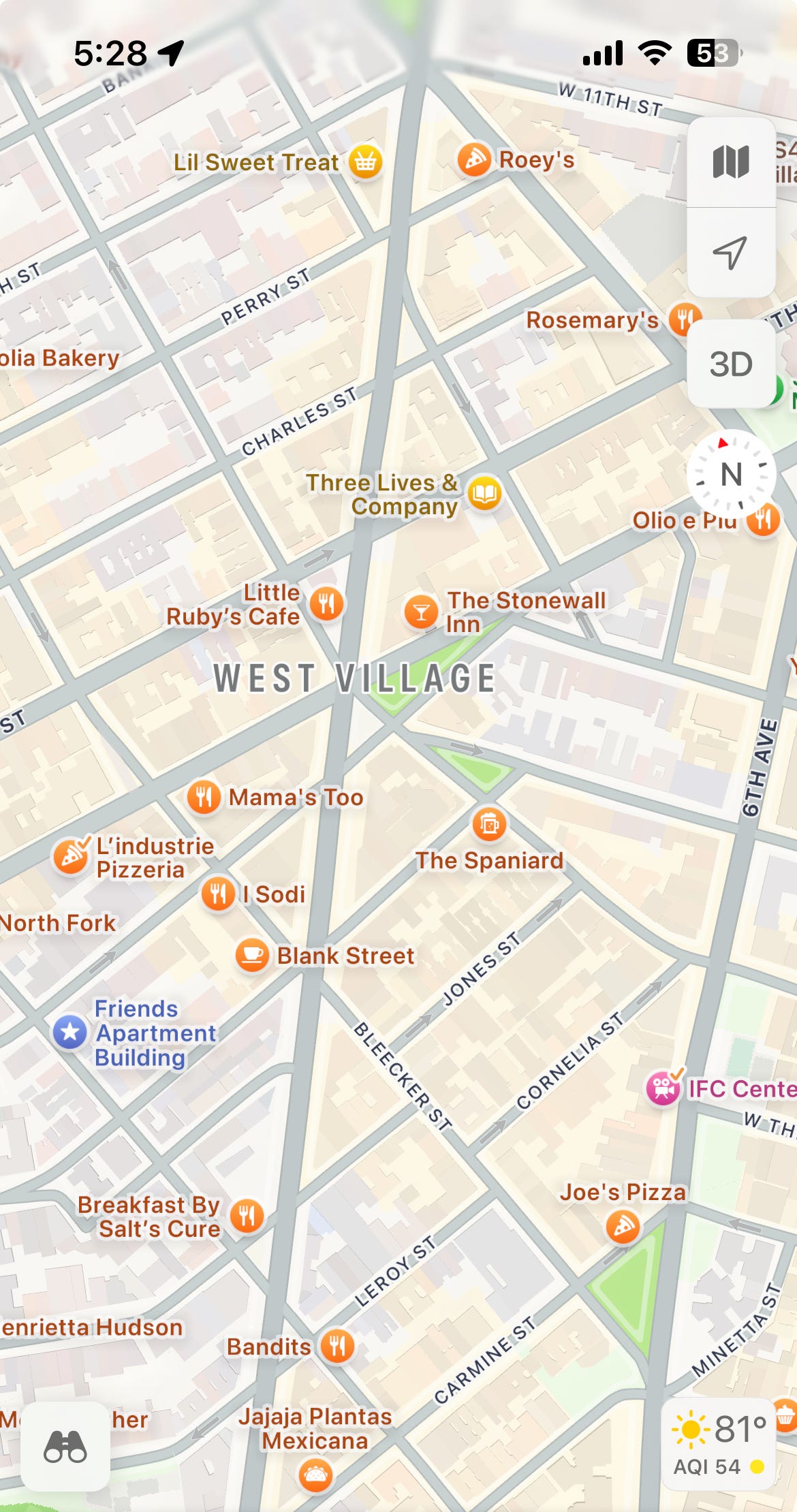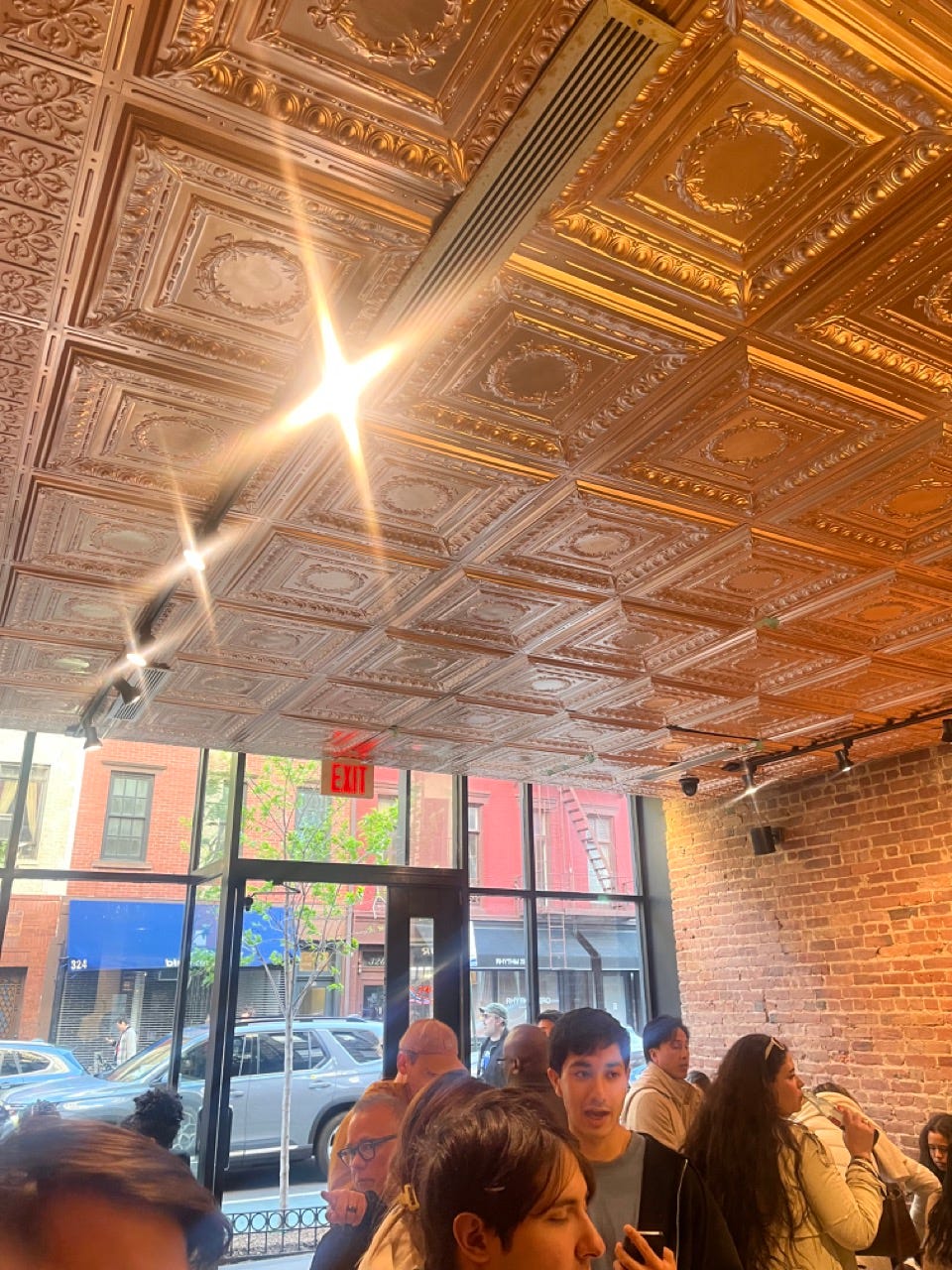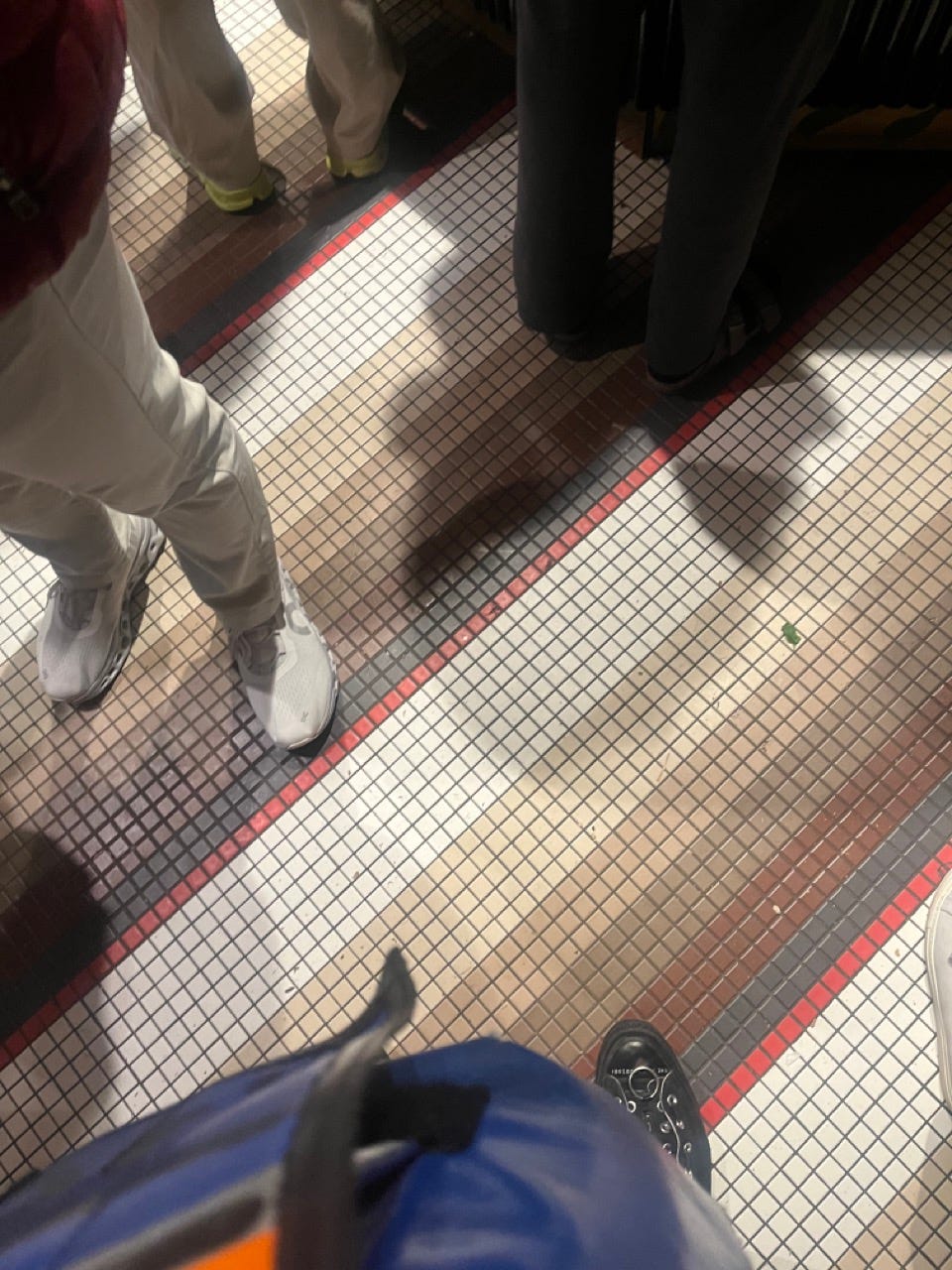A question I’ve heard often: when does someone become a New Yorker?
A question I’ve heard less often: what does your ideal 25$ sandwich look like?
Trick question: no 25$ sandwich is ideal.
Regardless, we all find ourselves ordering an expensive sandwich sooner or later, be it at a birthday dinner, a barren airport, or in gentrified wastes. In the 2020s, one cannot escape from this sandwich. So, if it’s an inevitable evil, what is its ideal form?
There is a square mile of New York City that straddles the edge of Greenwich Village and the West Village. I imagine 6th avenue as its border and IFC, my personal temple of cinema, as its center. When I first wandered New York alone I discovered IFC around the same time I discovered the dollar slice. I saw Memoria there, I wolfed down a slice on the way, sobbed (because of both) and the moment stuck. IFC has the best programming of the New York repertory theaters I’ve encountered, but one of the most heinous ticket price-theater experience trade offs of the pack - expect 20$ and stale popcorn for a living room sized theater perched 45 feet above the F train. It is my expensive, imperfect home.
Before or after a movie comes a meal, and this square mile contains a pizza debate between legacy pies and wide eyed newcomers. Joe’s pizza is around the corner from IFC, 10 minutes more and you reach the second location for L’Industrie Pizza, and in between is Mama’s Too. Joes is a pizza standard (love or hate), convenient in location but not in their cash only policy. A slice runs around 5$. L’industrie is a solid shoe in for best slice in the city - everything fresh, perfect crust, gargantuan in proportion, and at almost the same cost as Joe’s. The real price of the slice comes more from the snaking line that greets you at L’Industrie, recalling the sentiments of a scorned New Yorker’s refrain: the city is large and diverse enough that if you wait in a line, it’s because you aren’t curious or knowledgeable enough to game the system. I could not find the tweet that words this more eloquently.
The L’Industrie line reveals my deepest insecurities as a transplant. I have found a perfect pizza and it has blinded me into searching for others, so I am doomed to wait with the hipsters. Settling.
Like L’Industrie, the West Village Mama’s Too is the restaurant’s second outpost as a result of internet acclaim. They’re known for hefty grandma slices and sandwiches, but not so known that the line moves outside. The glassy, manicured exterior of Mama’s Too holds its adherents tightly inside, shielding them from line judgement or acknowledgement of reading Eater.
I have 7:15 Barry Lyndon tickets at IFC, I arrive in the area at 6:45. I’m wearing a suit jacket from work. All of this does not bode well for me. I don’t have the time for L’Inddustrie, the cash for Joe’s. This is how I end up at Mama's Too.
After waiting in line for five minutes I decide, as if cosmically wrong headed, to order the chicken a la vodka sandwich so to deviate from the slices and make the line and the lateness “worth it“. Anyway I’ve had their slice and it was very good, but a dollar more than standard and always featuring one topping in excess. A pepperoni slice is sticky with hot honey, a “cacio e Pepe” slice is all white goo. So I order the sandwich. It is 25$ with tip.
I’m waiting, standing beside the curtain the hides the bathroom door, watching NYU students and trust fund kids grasp for their slices. A delivery man tries desperately to fit three pizza boxes in a carrier. My order does not arrive. Someone wiggles into the packed waiting crowd to very slowly refill the napkin dispenser. It hits seven o’clock. I am in yuppie hell, 25$ poorer, and spiritually wounded. I have done this to myself.
Best case scenario when I receive my sandwich is it is wrapped tightly in tinfoil. Cut in two would be a dream. This means I can put the sandwich in my bag and run to my screening, safely and cleanly steal a bite on the way there.
The sandwich is almost six inches tall, a roll with stalagmites of squarish fried chicken jutting out from a bed of arugula, and completely saturated with vodka sauce, pesto, and molten mozzarella. It arrives like as a pulsing, saucy Italian organ on a sheet of parchment paper and the checkerboard paper plates usually reserved for hot dogs or fried Oreos.
If Mama’s Too is a temple of yuppie indignity this sandwich is its vaulted relic. The sandwich is not bad, but it is more ridiculous than it is good. It is impossible to touch the sandwich without getting your hands wet, it is so awkwardly wide and saucy that spillage is inevitable. Each element of the sandwich exists as separate and battling icon of itself, bucking and squirming for attention. Pesto, tomato, chicken, puffy roll, all seem to speak asynchronously - as if forced together algorithmically. It is messy for messiness sake, huge and impossible because it can be. It exists so to be an idea of itself, the equivalent of a neon sign that says “slutty for margaritas.“ Equally charmless and flimsily corporate, the chicken a la vodka encourages and celebrates excess without interest in perfection/freshness/fascination - just more and more and more until you are convinced, if not totally saturated.
I have to process and experience this while speed walking through the West Village at golden hour, past the grizzled authors and 0% body fat homosexuals and tall women in Toteme coats. They are leading their prim lives of inherited wealth, rent control, and segregation and they cringe watching a 6ft queer in a blazer attempt to down a chicken a la vodka sandwich at a red light with two very small paper napkins wet and small with red liquid. People glance at me, surveying my misfortune as quickly as they can bear. They judge, and I join in.
At a certain point I can’t even walk with this sandwich, and so I go to a side street and crouch beside a set of trash cans, my head spinning, my movie beginning in 5 minutes. I am no longer a lumbering sauce spitting colossus infiltrating New York’s millennial proper, I am one with the trash.
A mother and child walk out of their apartment twenty feet away. First the mother looks, a mildly confused horror on her brow, then the child looks at me. For a second I think the mother is going to shield her child’s eyes, that’s how wide eyed the kid looks at me.
Stumbling into my movie, late, stained, heaving, and ashamed, I somehow pass every better option. Joe’s greasy slice looks pristine in comparison, the proud Papaya Dog cheap and compact (hot dogs! How could I forget hot dogs!), Even IFC’s dry popcorn teases me.
I recount my sins, pounding my chest like for a Tri-State Area specific Yom Kippur:
Getting in the line. Paying the price. Eating the sandwich in the street. Not taking out cash. Lateness. Hubris. Public Degradation. Ruining the West Village afternoons of gay men who have suffered enough. Supporting inauthentic Italian cuisine. Hubris.
Moments like these are essential to ensuring New York is not solely a playground, but a place where there are codes and conducts and cultures established over centuries. It is not a reskinned globalized map for jet setting gentrifiers and clout chasers to skim, carefully checking off places they found on Tik Tok. It is easier than ever to live in New York within a bubble of privilege, scrolling for the next reservation, logo, spritzer, line to lust after. When New York becomes just another collection of themed listicles, what’s the point?
Things must be learned the hard way, transplants must be put in their place. Myself included. Tactile humiliation, othering, and a 25$ charge is ample punishment for these sins.
My Grandmother was born in Manchester, but spent most of her life in Los Angeles. She never lost her Northern English accent, it was just slowly diluted by California Standard English. She did not transform into an Angeleno exclusive from her Britishness, she became an amalgamation. The truth about transplants is that they will not one day morph into a local. There is always the creeping understanding that they will sin again, that their lack of locality will somehow define their relationship to a new home.
To return to the original question: I think the only New Yorkers are New Yorkers. To choose to call a place home always means work, time, humiliation, and masochism - to ignore this is to ignore the distinctness of community, and to ignore history. Perhaps so many obsess about “authenticity“ or “community” because so many have stopped seeking these things, uninterested in learning the rules or adapting to new communities.
The answer to the other question remains the same: there is no ideal 25$ sandwich. However, the only way to figure this out is to try one, and suffer the eyes of a young New Yorker watching you scarf it down in the gutter.








